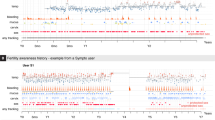Abstract
We present new results related to retrospective detection of ovulation days basing on information entered by the users of one of online platforms available in the market. Comparing to our previous studies, we improve the accuracy of algorithms which are based on evaluation and synthesis of multivariate data sources. Results are reported for 224 menstrual cycles which were labeled by medical experts. In the experiments, we pay special attention to the aspect of uncertainty associated with the tagging process.
Co-financed by the EU Smart Growth Operational Programme 2014–2020 under the project “Development of New World Scale Solutions in the Field of Machine Learning Supporting Family Planning and Overcoming the Infertility Problem”, POIR.01.01.01-00-0831/17-00.
Access this chapter
Tax calculation will be finalised at checkout
Purchases are for personal use only
Similar content being viewed by others
References
Sosnowski, Ł., et al.: Similarity-based detection of fertile days at OvuFriend. In: Proceedings of IEEE BigData 2018, pp. 2663–2668 (2018)
Sosnowski, Ł.: Compound objects comparators in application to similarity detection and object recognition. Trans. Rough Sets 21, 169–300 (2019)
Scherwitzl, E.B., Hirschberg, A.L., Scherwitzl, R.: Identification and prediction of the fertile window using NaturalCycles. Eur. J. Contracept. Reprod. Health Care 20(5), 403–408 (2015)
Su, H.W., Yi, Y.C., Wei, T.Y., Chang, T.C., Cheng, C.M.: Detection of ovulation, a review of currently available methods. Bioeng. Transl. Med. 2(3), 238–246 (2017)
Sohda, S., Suzuki, K., Igari, I.: Relationship between the menstrual cycle and timing of ovulation revealed by new protocols: analysis of data from a self-tracking health app. J. Med. Internet Res. 19(11), e391 (2017)
Koch, M., et al.: Improving usability and pregnancy rates of a fertility monitor by an additional mobile application: results of a retrospective efficacy study of Daysy and DaysyView app. Reprod. Health 15, 37 (2018)
Shilaih, M., Goodale, B.M., Falco, L., Kübler, F., De Clerck, V., Leeners, B.: Modern fertility awareness methods: wrist wearables capture the changes of temperature associated with the menstrual cycle. Biosci. Rep. 38(6) (2018). https://www.ncbi.nlm.nih.gov/pmc/articles/PMC6265623/
Kutt, K., Nalepa, G.J., Giżycka, B., Jemioło, P., Adamczyk, M.: BandReader - a mobile application for data acquisition from wearable devices in affective computing experiments. In: Proceedings of HSI 2018, pp. 42–48 (2018)
Afanasieva, T., Yarushkina, N., Toneryan, M., Zavarzin, D., Sapunkov, A., Sibirev, I.: Time series forecasting using fuzzy techniques. In: Proceedings of IFSA-EUSFLAT 2015, pp. 1068–1075 (2015)
Fukaya, K., Kawamori, A., Osada, Y., Kitazawa, M., Ishiguro, M.: The forecasting of menstruation based on a state-space modeling of basal body temperature time series. Stat. Med. 36(21), 3361–3379 (2017)
Iglesias, F., Kastner, W.: Analysis of similarity measures in times series clustering for the discovery of building energy patterns. Energies 6(2), 579–597 (2013)
Tsumoto, S., Iwata, H., Hirano, S., Tsumoto, Y.: Similarity-based behavior and process mining of medical practices. Future Gener. Comput. Syst. 33, 21–31 (2014)
Yimam, S.M., Biemann, C., Majnaric, L., Šabanović, Š., Holzinger, A.: Interactive and iterative annotation for biomedical entity recognition. In: Guo, Y., Friston, K., Aldo, F., Hill, S., Peng, H. (eds.) BIH 2015. LNCS (LNAI), vol. 9250, pp. 347–357. Springer, Cham (2015). https://doi.org/10.1007/978-3-319-23344-4_34
Hu, B., Jiang, X., de Souza, E.N., Pelot, R., Matwin, S.: Identifying fishing activities from AIS data with conditional random fields. In: Proceedings of FedCSIS 2016, pp. 47–52 (2016)
Dunselman, G.A.J., et al.: ESHRE guideline: management of women with endometriosis. Hum. Reprod. 29(3), 400–412 (2014)
Meena, D.K., Manimekalai, D.M., Rethinavalli, S.: Implementing neural fuzzy rough set and artificial neural network for predicting PCOS. Int. J. Recent Innov. Trends Comput. Commun. 3(12), 6722–6727 (2015)
Fox, F., Aggarwal, V.R., Whelton, H., Johnson, O.: A data quality framework for process mining of electronic health record data. In: Proceedings of ICHI 2018, pp. 12–21 (2018)
Szczuka, M.S., Sosnowski, Ł., Krasuski, A., Kreński, K.: Using domain knowledge in initial stages of KDD: optimization of compound object processing. Fundamenta Informaticae 129(4), 341–364 (2014)
Ślęzak, D., Glick, R., Betliński, P., Synak, P.: A new approximate query engine based on intelligent capture and fast transformations of granulated data summaries. J. Intell. Inf. Syst. 50(2), 385–414 (2018)
Emrouznejad, A., Marra, M.: Ordered weighted averaging operators 1988–2014: a citation-based literature survey. Int. J. Intell. Syst. 29(11), 994–1014 (2014)
Kuncheva, L.I., Diez, J.J.R.: A weighted voting framework for classifiers ensembles. Knowl. Inf. Syst. 38(2), 259–275 (2014)
Sosnowski, Ł., Szczuka, M.: Defuzzyfication in interpretation of comparator networks. In: Medina, J., et al. (eds.) IPMU 2018, Part II. CCIS, vol. 854, pp. 467–479. Springer, Cham (2018). https://doi.org/10.1007/978-3-319-91476-3_39
Widz, S.: Introducing NRough framework. In: Polkowski, L., et al. (eds.) IJCRS 2017, Part I. LNCS (LNAI), vol. 10313, pp. 669–689. Springer, Cham (2017). https://doi.org/10.1007/978-3-319-60837-2_53
Skowron, A., Wang, H., Wojna, A., Bazan, J.: A hierarchical approach to multimodal classification. In: Ślęzak, D., Yao, J.T., Peters, J.F., Ziarko, W., Hu, X. (eds.) RSFDGrC 2005, Part II. LNCS (LNAI), vol. 3642, pp. 119–127. Springer, Heidelberg (2005). https://doi.org/10.1007/11548706_13
Author information
Authors and Affiliations
Corresponding author
Editor information
Editors and Affiliations
Rights and permissions
Copyright information
© 2019 Springer Nature Switzerland AG
About this paper
Cite this paper
Fedorowicz, J. et al. (2019). Multivariate Ovulation Window Detection at OvuFriend. In: Mihálydeák, T., et al. Rough Sets. IJCRS 2019. Lecture Notes in Computer Science(), vol 11499. Springer, Cham. https://doi.org/10.1007/978-3-030-22815-6_31
Download citation
DOI: https://doi.org/10.1007/978-3-030-22815-6_31
Published:
Publisher Name: Springer, Cham
Print ISBN: 978-3-030-22814-9
Online ISBN: 978-3-030-22815-6
eBook Packages: Computer ScienceComputer Science (R0)




